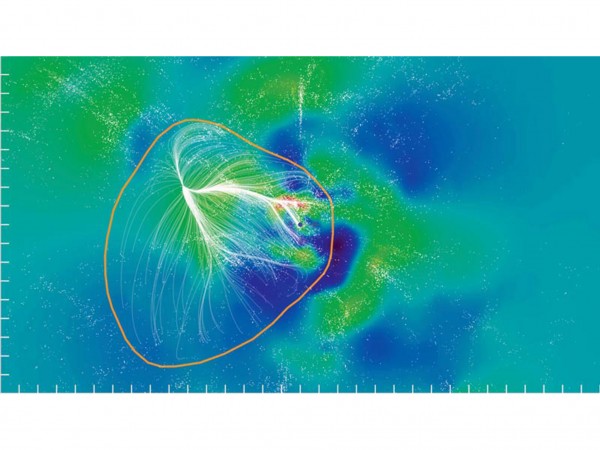







| BOOKS | F. A. Q. | ARTICLES | TALKS | ABOUT KEN | DONATE | BEYOND OUR KEN |
|---|
By Ken Croswell
Published on ScienceNOW (September 3, 2014)

Credit: SDvision interactive visualization software by DP at CEA/Saclay, France.
If aliens ever abduct you to a galaxy far, far away, this map might help you find your way back home. Presented online today in Nature, the map spans more than 1.5 billion light-years, coloring the densest concentrations of observed galaxies red and areas with the fewest galaxies blue. Your home galaxy, the Milky Way, is the blue dot at the center. The red region above the Milky Way includes Virgo, the closest galaxy cluster, about 55 million light-years from Earth. The orange curve illustrates the key finding of the new work: it encircles galaxies that would fall toward one another along the curved white lines if space weren't expanding; the astronomers have named this huge assemblage Laniakea, after Hawaiian words for "spacious heaven." It is 100 quadrillion times as massive as the Sun�equivalent to 100,000 Milky Ways�and stretches across more than half a billion light-years of space. Outside Laniakea, other galactic gatherings appear green on the map: the Shapley Concentration at the upper left; the Coma Supercluster at the top; and the Pisces-Perseus Supercluster at the right.
Ken Croswell earned his Ph.D. in astronomy from Harvard University and is the author of The Alchemy of the Heavens and The Lives of Stars.
"An engaging account of the continuing discovery of our Galaxy...wonderful." --Owen Gingerich, The New York Times Book Review. See all reviews of The Alchemy of the Heavens here.
"A stellar picture of what we know or guess about those distant lights."--Kirkus. See all reviews of The Lives of Stars here.
| BOOKS | F. A. Q. | ARTICLES | TALKS | ABOUT KEN | DONATE | BEYOND OUR KEN |
|---|